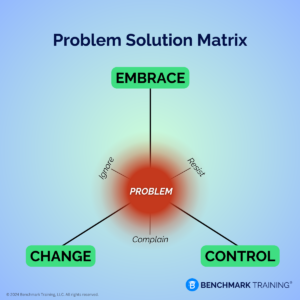When things don’t go according to plan and problems arise, frustrations often increase. Whether it is a technical glitch, a miscommunication between coworkers, or delays out of our control, problems can disrupt workflow and create stress.
Ignoring, complaining, or resisting a problem are common reactions to the frustration you feel. And all three of these responses have one thing in common: they solve nothing.

We all wish we could live in a world where problems could be ignored, but unfortunately, things don’t work that way, and ignoring them could make things even worse. Sometimes, complaining about a problem makes you feel better, allowing you to release some frustration, but the problem does not get any smaller. Then, there are times when you want to resist the problem, place the blame on someone else, or downplay the significance.
You can complain about and ignore your problems all you want, but that won’t get you anywhere; the problem remains a problem, and you have exerted all that energy only to accomplish nothing. Instead, turn your energy to solving the problem.
When faced with a problem, you have three choices that will help you find a solution and reach your original objective: Change the Narrative, Embrace the Challenge, or Control What You Can.
Change the Narrative
Changing the narrative requires a shift in perspective from frustration and defeat to one of possibility and opportunity. Instead of wasting time and energy dwelling on the negative aspects of the situation, you can better use your resources to identify potential solutions and take proactive steps to address the issue. This will involve reframing the problem as a puzzle to solve or view it as a chance to innovate and improve your processes.
By changing the narrative, you empower yourself to approach challenges with creativity and optimism, knowing that every problem presents an opportunity for growth and development. This positive mindset will not only fuel your motivation to overcome obstacles but also foster a culture of resilience and adaptability within the workplace.
- Reframe Problems as Opportunities: Start training yourself to see problems as opportunities for growth and innovation instead of obstacles to avoid. By reframing the narrative surrounding challenges, you will start to see the potential for learning and improvement.
- Practice Positive Self-Talk: Monitor your internal dialogue and challenge negative thoughts that perpetuate the defeatist mindset. Replace self-doubt with affirmations that reinforce your capabilities and resilience in the face of adversity.
- Visualize Success: Envision yourself successfully overcoming the challenge. Visualization techniques can help boost your confidence and mental toughness, enabling you to approach problems with a positive mindset.
Embrace the Challenge
While ignoring and avoiding the problem altogether is tempting, doing so only prolongs the issue and allows it to fester. One way to deal with problems is to embrace them. Most of the time when you run into a problem you tend to see it in a negative light. Unexpected problems can be a hassle to deal with, but they tend to pave the way for new opportunities.
When you embrace challenges with a positive attitude, you will develop a sense of optimism and willingness to learn from past experiences. This proactive attitude not only enables you to navigate difficult situations more effectively but also empowers you to emerge stronger and more resilient in the face of adversity.
If you are looking for ways to embrace the challenge, here are some tips to help get you started:
- Point fingers at the process, not the people: Instead of dwelling on who or what caused the problem, focus your energy on finding solutions in the process. Take a proactive approach to problem-solving and focus on actionable steps you can take to address the issue effectively.
- Seek Feedback and Support: Reach out to your colleagues and supervisors for advice and support. Their perspective and experience will provide valuable insights and help you approach problems from new angles.
- Stay Flexible and Adapt: Be willing to adapt to changing circumstances and explore alternative approaches. Flexibility allows you to pivot when necessary and find creative solutions to unexpected challenges.
Control What You Can
You do not have the power to control everything you want. If you did, everything would go according to plan and problems would not exist. It is not uncommon to encounter problems that are beyond your immediate control. Whether it is market fluctuation, external regulations, or unexpected events, these factors can disrupt plans and derail progress.
If you cannot control these external factors, then what can you control? You are in control of your attitude, response, and actions. This involves reframing your approach to problem-solving and shifting from a reactive stance to a strategic one.
- Set Clear Goals: Ensure that your goals are defined and actionable, or even better, SMART. This approach provides a structured framework that not only guides your problem-solving efforts but also gauges your progress more effectively.
- Prioritize Tasks: Once you have a clearly defined goal, you need to prioritize each task so that you allocate time and resources accordingly. Prioritizing tasks ensures that you focus your energy on activities that have the most significant impact on addressing the problem.
- Learn from Setbacks: Setbacks are opportunities for growth and learning; not failures. Analyze what went wrong, extract the valuable lessons from the experience, and apply them to future problem-solving efforts.
Problems in the workplace are not merely sources of frustration; they are opportunities for growth and innovation. By embracing challenges, changing the narrative, and focusing on what you can control, professionals can transform problems into stepping stones toward success. Instead of viewing problems as obstacles to be avoided, see them as opportunities to learn, adapt, and thrive in an ever-changing work environment. With a proactive approach to problem-solving, you can turn challenges into catalysts for personal and professional development.
How Can Benchmark Training Help You?
When you partner with Benchmark Training, you are taking the first step in Building a Culture of Profitability Through People Development®.
Whether it is enhancing problem-solving skills, fostering proactive mindsets, or optimizing resource management, we are here to equip you with the tools and techniques needed to thrive in today’s dynamic work environment.
Contact us today to explore how our tailored solutions can empower you and your team to conquer obstacles and achieve sustainable success.




